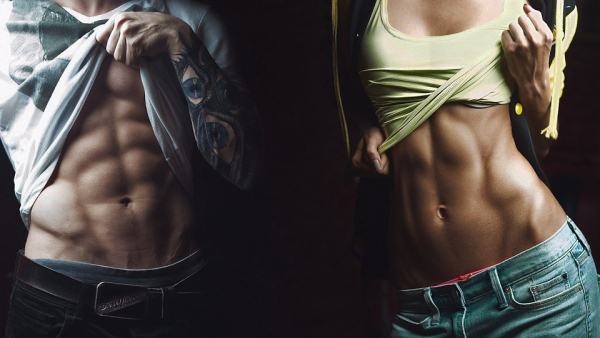Is There a Cheat Code to Get Six-Pack Abs Faster?
Ripped, chiseled abs are the holy grail of many fitness enthusiasts. They tell the world you’re strong and lean and that lasagna has no sway over you. And they’re not easy to achieve.
Athletes aside, most people have abdominal muscles veiled by a layer of fat. Some of it is near the surface of the skin (subcutaneous fat). Some of it is deep within the abdominal cavity itself (visceral fat).
The more fat you have, the longer it will take to shed it and then to showcase six-pack abs.
What’s a six-pack?
The major muscle in the abdomen responsible for that washboard appearance is the rectus abdominis. It’s a long, flat band of fibers that extends vertically from the pubic bone to under the ribs. It lies over the internal organs and functions to help hold these organs in their proper place.
It’s a divided muscle with a right and a left half that run parallel to each other. Each half is divided into three segments by connective tissue. These six bands of connective tissue are what give the abdomen its “six-pack” appearance.
Regardless of how well-toned your rectus abdominis is, if it’s hidden under layers of fat, your six-pack won’t be visible.
According to Harvard Health, roughly 90 percent of body fat is subcutaneous, meaning it lies just under the skin. It’s the squishy stuff that forms your belly and is a body fat that you can grab with your hands.
About 10 percent of fat is the visceral variety. This fat lies beneath the abdominal wall and in the spaces that envelop the intestines and liver.
It secretes hormones and other substances that cause low-level inflammation, which has a direct effect on the development of things like heart disease, dementia, and certain cancers.
Doing targeted exercises like crunches is great for toning abdominal muscles, but losing both subcutaneous and visceral fat is the first step to unearthing your abs.
According to the American Council on Exercise (ACE), you’ll need to lower your body fat to about 14 to 20 percent for women and 6 to 13 percent for men. On a scale used by ACE, this is known as the “athletes” category.
Even then, some people don’t have the genetic makeup necessary for six-pack abs. That’s because they may have thicker skin and tissue surrounding the rectus abdominis, making it harder for ripped abs to show.
Some people also have asymmetrical or angled tendons crossing over the rectus abdominis, making their abs look less like a washboard.
Lowering your body fat level
Lowering your body fat percentage can be a long and painstaking process.
Research published in the journal Obesity notes that in the United States, the average woman has about 40 percent body fat and the average man has about 28 percent. Women naturally carry more fat than men because of the hormone estrogen.
Most men and women have to lose at least half their body fat for their abs to show. The American Council on Exercise says a 1 percent body fat loss per month is safe and achievable.
What you should do to get abs
The good news is that you have abs. The bad news is that there’s no quick and easy way to unearth them. Exercising your abdominal muscles with targeted exercises will help to strengthen and shape them.
Reduce calories
Cut about 500 calories from your daily diet if you want to lose one pound a week.
If you’re exercising, you may be able cut fewer calories. If you burn 250 calories by working out daily, you may need to only cut calories by 250.
Increase protein intake
When you lose weight, you also lose lean muscle. To help maintain muscle mass, it’s important to consume adequate amounts of protein, the building block of muscle.
Aim for roughly 1 to 1.5 grams for every two pounds you weigh.
One analysis published in Nutrition Reviews noted that while trying to lose weight, those who ate higher-than-average amounts of protein (1.2 to 1.5 grams per 2.2 pounds of body weight) were able to preserve lean muscle mass and improve body composition compared to those who ate average amounts of protein (0.8 grams per 2.2 pounds).
That translates into more than 90 grams of protein — 30 grams per meal, per day for a 150-pound person.
Protein-rich foods include chicken, beef, turkey, legumes, nuts, and certain dairy products like Greek yogurt.
Choose high-intensity intermittent exercise
Examples of high-intensity intermittent exercise include:
- sprinting for 20 seconds followed by walking for 40, and repeat
- cycling at an all-out pace for 8 seconds followed by a low-intensity pace for 12 seconds
According to research published in the Journal of ObesityTrusted Source, women who performed that type of cycling exercise for 20 minutes, three times a week, for 15 weeks, lost more body fat than those who performed steady aerobic exercise.
Add resistance training
Cardio plus lifting weights seems to be the magic bullet when it comes to losing fat.
In one study looking at overweight adolescents, those who did cardio work for 30 minutes and strength training for 30 minutes, three times a week for one year, lost more body fat and whittled their waist circumference more than those who just did aerobic exercise.
3 Mindful Moves to Strengthen Abs
- Twisted Crunch
- Kick Crunch
- Hollow Body Hold
The takeaway
There is no quick and easy way to get six-pack abs. It involves discipline and a commitment to clean, healthy eating and regular exercise, including cardio and strength training.
But while the process can be long and the work hard, six-pack abs are a fitness goal that can be attained by those who are committed to the process.









